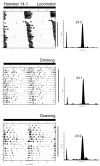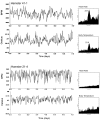Targeted microlesions reveal novel organization of the hamster suprachiasmatic nucleus
- PMID: 15014120
- PMCID: PMC3271853
- DOI: 10.1523/JNEUROSCI.5323-03.2004
Targeted microlesions reveal novel organization of the hamster suprachiasmatic nucleus
Abstract
The role of the suprachiasmatic nuclei (SCN) in generating circadian rhythms in physiology and behavior is well established. Recent evidence based on clock gene expression indicates that the rodent SCN are composed of at least two functional subdivisions. In Syrian hamsters (Mesocricetus auratus), cells in a subregion of the caudal SCN marked by calbindin-D(28K) (CalB) express light-induced, but not rhythmic, clock genes (Per1, Per2, and Per3). In the SCN region marked by vasopressinergic cells and fibers, clock gene expression is rhythmic. Importantly, lesions of the CalB subregion that spare a significant portion of the SCN abolish rhythms in locomotor behavior. One possibility is that the CalB subregion is required to maintain SCN function necessary to support all behavioral and physiological rhythms. Alternatively, this subregion may control circadian rhythms in locomotor behavior, whereas other circadian responses in physiology and behavior are sustained by different SCN compartments. The present study sought to distinguish between these possibilities by examining the role of the CalB subregion in a battery of rhythms within an individual animal. The results indicate that lesions of the CalB subregion of the SCN abolish circadian rhythms in behavior (locomotion, drinking, gnawing), physiology (body temperature, heart rate), and hormone secretion (melatonin, cortisol), even when other SCN compartments are spared. Together, these findings suggest a novel fundamental property of SCN organization, with a subset of cells being critical for the maintenance of SCN function manifest in circadian rhythms in physiology and behavior.
Figures









Similar articles
-
Targeted mutation of the calbindin D28K gene disrupts circadian rhythmicity and entrainment.Eur J Neurosci. 2008 Jun;27(11):2907-21. doi: 10.1111/j.1460-9568.2008.06239.x. Eur J Neurosci. 2008. PMID: 18588531 Free PMC article.
-
Organization of suprachiasmatic nucleus projections in Syrian hamsters (Mesocricetus auratus): an anterograde and retrograde analysis.J Comp Neurol. 2004 Jan 12;468(3):361-79. doi: 10.1002/cne.10995. J Comp Neurol. 2004. PMID: 14681931 Free PMC article.
-
Localization of a suprachiasmatic nucleus subregion regulating locomotor rhythmicity.J Neurosci. 1999 Jul 1;19(13):5574-85. doi: 10.1523/JNEUROSCI.19-13-05574.1999. J Neurosci. 1999. PMID: 10377364 Free PMC article.
-
Output signals of the SCN.Chronobiol Int. 1998 Sep;15(5):535-50. doi: 10.3109/07420529808998706. Chronobiol Int. 1998. PMID: 9787940 Review.
-
Melatonin, the pineal gland, and circadian rhythms.J Biol Rhythms. 1993;8 Suppl:S73-81. J Biol Rhythms. 1993. PMID: 8274765 Review.
Cited by
-
Disintegration of the sleep-wake cycle and circadian timing in Huntington's disease.J Neurosci. 2005 Jan 5;25(1):157-63. doi: 10.1523/JNEUROSCI.3842-04.2005. J Neurosci. 2005. PMID: 15634777 Free PMC article.
-
Minireview: The neuroendocrinology of the suprachiasmatic nucleus as a conductor of body time in mammals.Endocrinology. 2007 Dec;148(12):5640-7. doi: 10.1210/en.2007-1083. Epub 2007 Sep 27. Endocrinology. 2007. PMID: 17901227 Free PMC article. Review.
-
Dissecting the Roles of the Autonomic Nervous System and Physical Activity on Circadian Heart Rate Fluctuations in Mice.Front Physiol. 2021 Oct 18;12:692247. doi: 10.3389/fphys.2021.692247. eCollection 2021. Front Physiol. 2021. PMID: 34733171 Free PMC article.
-
Reorganization of suprachiasmatic nucleus networks under 24-h LDLD conditions.J Biol Rhythms. 2010 Feb;25(1):19-27. doi: 10.1177/0748730409352054. J Biol Rhythms. 2010. PMID: 20075297 Free PMC article.
-
Targeted mutation of the calbindin D 28k gene selectively alters nonvisual photosensitivity.Eur J Neurosci. 2011 Jun;33(12):2299-307. doi: 10.1111/j.1460-9568.2011.07689.x. Epub 2011 May 5. Eur J Neurosci. 2011. PMID: 21545657 Free PMC article.
References
-
- Abrahamson EE, Moore RY (2001) Suprachiasmatic nucleus in the mouse: retinal innervation, intrinsic organization and efferent projections. Brain Res 916: 172-191. - PubMed
-
- Arvanitogiannis A, Robinson B, Beaule C, Amir S (2000) Calbindin-D28k immunoreactivity in the suprachiasmatic nucleus and the circadian response to constant light in the rat. Neuroscience 99: 397-401. - PubMed
-
- Buijs RM, Chun SJ, Niijima A, Romijn HJ, Nagai K (2001) Parasympathetic and sympathetic control of the pancreas: a role for the suprachiasmatic nucleus and other hypothalamic centers that are involved in the regulation of food intake. J Comp Neurol 431: 405-423. - PubMed
Publication types
MeSH terms
Substances
Grants and funding
LinkOut - more resources
Full Text Sources
